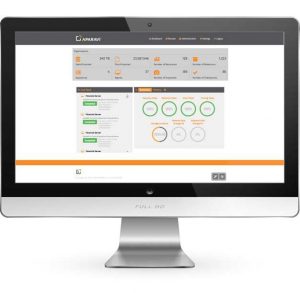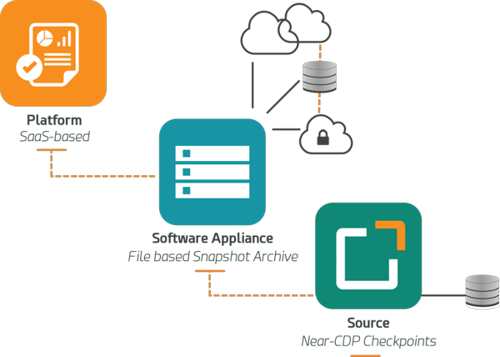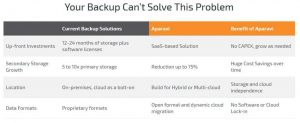Aparavi: Enhanced Active Archive Platform
Improving resource management and operational efficiency
This is a Press Release edited by StorageNewsletter.com on March 29, 2019 at 2:25 pmAparavi Software Corporation announced enhancements to its Active Archive platform, delivering improved resource management and operational efficiency, as well as enhanced insight and management of archived data.
 Features include direct-to-cloud data transfer along with the next generation of data classification, tagging, and full-content search. Enhanced multi-cloud management includes the addition of several new cloud destinations, along with bulk data migration across clouds.
Features include direct-to-cloud data transfer along with the next generation of data classification, tagging, and full-content search. Enhanced multi-cloud management includes the addition of several new cloud destinations, along with bulk data migration across clouds.
Launched May 2018, Active Archive is being embraced by organizations grappling with the huge volume of unstructured data retained for purposes such as compliance, historical reference, and business reporting/analytics. The firm’s intelligent multi-cloud data management provides the ability to actively manage data for long-term policy-based retention, open access, and re-use, while providing an easy path to multi-cloud adoption.
“Aparavi has helped us greatly with our client’s initiatives to move data to the cloud for long-term retention,” said Brian Ricci, president, Pinnacle Computer Services. “With these new features we can more easily organize and manage the vast amounts of data stored, and find specific data as needed by an organization. It’s a real game-changer.“
Features include:
-
Direct-to-cloud for improved resource management and operational efficiency
Direct-to-cloud provides the ability to archive data directly from source systems to the cloud destination of choice, with minimal local storage requirements. This substantially decreases the on-premises storage and compute requirements, simplifies set up, and removes the need for a dedicated software appliance. On-premise storage resources do not need to be allocated for data staging, and data can be pushed directly to one or more cloud destinations. -
Next-gen data classification and tagging for better management and simplified access
Updated classification and tagging capabilities make it simple to classify data based on individual words, phrases, dates, file types, and patterns. Users can identify and tag data for future retrieval purposes such as compliance, reference, or analysis. Examples would be classifying all PHI (Personal Health Information), PII (Personally Identifiable Information), or legal files. The firm includes pre-set classifications of ‘confidential,’ ‘legal,’ and PII; ad hoc additions are created with a few simple steps. -
Next gen search for greater insight and access
A query interface allows users to find any data wherever it resides in the archive, whether on-premises or in one or multiple clouds, without having to know the location. Aside from ‘Google-like’ full-content search by words, phrases, or patterns files can be searched by their metadata, including classification, tag, date, file name, file type, or optional wildcards. Results are returned intelligently in context for easier identification, and are viewed in the cloud or storage destination without retrieving until requested. Current file types supported include any text file, PDF, and modern Microsoft Office formats. Future updates will add images and older Microsoft Office formats. -
Enhanced multi-cloud management and bulk-data migration
Additional cloud destinations have been added and together include AWS, Backblaze B2, Caringo, Cloudian, IBM Cloud, Microsoft Azure, Oracle Cloud, Scality, and Wasabi. The company’s multi-cloud support enables users to select the best destination for their data, and adds support for new bulk migration to move data easily from one location to another, including on- or off-premises. Users can now take advantage of changing cloud economics at any time.
“Long-term retention is changing. It is no longer enough to simply store data for lengthy periods of time,” said Marc Staimer, president, Dragon Slayer Consulting. “Compliance, data migration, search, multi-cloud, and cost control of that data are all difficult problems IT organizations are wrestling with. Aparavi’s latest version tackles these problems head-on in a cost-effective manner.“
“We hear from customers all the time about their need to retain data for lengthy periods – often forever – but that they face real challenges in managing it effectively and efficiently,” said Adrian Knapp, CEO, Aparavi. “Our Active Archive platform with these enhancements provide the solution. That’s why we tell them, ‘Keep your data! Just do it better.“
Click to enlarge
Read also:
Aparavi Active Archive and Backblaze B2 Cloud Storage Interoperable
To achieve long-term data retention
March 7, 2019 | Press Release
Aparavi Active Archive Interoperable With Oracle Cloud
For multi-cloud data management on-premises, in Oracle Cloud Infrastructure or other repositories
November 14, 2018 | Press Release
Aparavi Active Archive Interoperable With IBM Cloud
Validated to support object storage APIs, having the framework to store objects on-premises, in cloud, or by acting as gateway to other storage devices
June 19, 2018 | Press Release
Aparavi: Active Archive Platform for Protection, Retention and Archive of Unstructured Data
With classification and retention policies, support for additional cloud platforms, advanced search, and simplified installation and deployment
May 22, 2018 | Press Release
















 Subscribe to our free daily newsletter
Subscribe to our free daily newsletter

